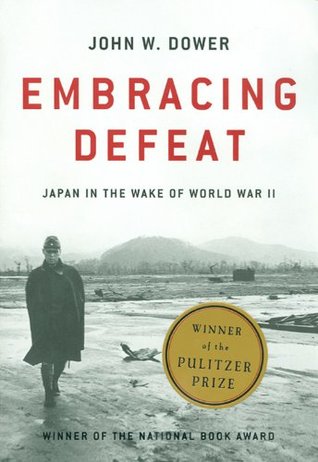More on this book
Community
Kindle Notes & Highlights
a little gem, the 1946 cartoon history of the occupation by Katō Etsurō.
indemnity,
Loans raised in New York and London helped to finance this war, and the Western powers turned a deaf ear to the appeals of Korean patriots.
chimera;
The most obvious legacy of the Greater East Asia Co-Prosperity Sphere was death and destruction. In China alone, perhaps 15 million people died. The Japanese lost nearly 3 million—and their entire empire as well.
troops
They found themselves seduced (far more than they realized)
Shattered lands, shattered peoples, shattered empires, and shattered dreams have been one of the central stories of our times.
Certainly, there is much to be learned from the world as viewed through the eyes of the defeated—not only about misery, disorientation, cynicism, and resentment, but also about hope, resilience, visions, and dreams.
World War II did not really end for the Japanese until 1952,
Japan remained under the control of fundamentally military regimes from the early 1930s straight through to 1952.
One of the most pernicious aspects of the occupation was that the Asian peoples who had suffered most from imperial Japan’s depredations—the Chinese, Koreans, Indonesians, and Filipinos—had no serious role, no influential presence at all in the defeated land. They became invisible. Asian contributions to defeating the emperor’s soldiers and sailors were displaced by an all-consuming focus on the American victory in the “Pacific War.” By this same process of vaporization, the crimes that had been committed against Asian peoples through colonization as well as war were all the more easily put
...more
The emperor’s active contribution to his country’s aggression had not been negligible,
giving familiar language new meaning is one of the ways people everywhere rationalize and legitimize substantive change.
emperor’s voice was high pitched and his enunciation stilted. He did not speak in colloquial Japanese,
The millions of Japanese who gathered around neighborhood radios to hear that broadcast were not “citizens” but the emperor’s subjects,
“endure the unendurable and bear the unbearable”—words
With reference to the recent atomic bombings of Hiroshima and Nagasaki, the emperor went on to present Japan’s decision to capitulate as nothing less than a magnanimous act that might save humanity itself from annihilation by an atrocious adversary.
3 million Japanese were dead,
It was essential to remain united as a great family,
the divine country”
at the official level, the most notable immediate response to the momentous broadcast of August 15 was pragmatic and self-serving.
wartime elites followed the lead of their sovereign and devoted themselves to obscuring their wartime deeds.
the policy of “unconditional surrender” of his deceased predecessor Franklin D. Roosevelt.
“Armageddon will be at our door” if the world did not learn to live in peace.
the terms of surrender committed the victors to liberate the Japanese people from a “condition of slavery”
“Although the inscrutable faces of their representatives gave no indication of their feelings,” he recalled, “their demeanor was so extremely somber as to indicate that they fully realized that their once-proud empire had been humbled into dust and that their national hopes and aspirations were at an end.”9 The future remained terribly uncertain, and the enormity of the nation’s humiliation had only begun to sink in.
At a thunderous theatrical moment, the sky was all but obscured by a fly-by of some four hundred glistening B-29 bombers accompanied by fifteen hundred Navy fighter planes.
The scene in Tokyo Bay, coming in the wake of the nuclear destruction of Hiroshima and Nagasaki, offered a stunning lesson in the kind of material strength and affluence that might be attained under American-style democracy.
In such circumstances, it was hardly surprising that few Japanese had the energy, imagination, or desire to dwell on how many other lives they had shattered in the course of carrying out their emperor’s holy war.
(SCAP, an acronym for Supreme Command[er] for the Allied Powers, was commonly used to refer to MacArthur’s command)
The first photographs and newsreel footage from the conquered land captured these endless vistas of urban rubble for American audiences thousands of miles away who had never really grasped what it meant to incinerate great cities.
Vast areas of poor people’s residences, small shops, and factories in the capital were gutted, for instance, but a good number of the homes of the wealthy in fashionable neighborhoods survived to house the occupation’s officer corps.
Railways still functioned more or less effectively throughout the country
Outside of devastated poor people’s neighborhoods, most utilities including electricity and water were also still in working order.
U.S. bombing policy, at least in the capital city, had tended to reaffirm existing hierarchies of fortune.l8
maltreatment by the victorious Allies.
The British, in charge of the repatriation of approximately three-quarters of a million Japanese from south and southeast Asia, made no bones about their intention to hold on to a large number for projects in areas where the European powers, having ousted the Japanese aggressors, were intent on reasserting their own colonial authority.
13,500 were later turned over to the Dutch, engaged in reimposing their rule over the former Netherlands East Indies.
The last of the Japanese detained by the British in Malaya and Burma were not repatriated until October 1947.25
By far the most extensive, protracted, and abusive treatment of surrendered forces came at the hands of the Soviets, who entered the war on August 8, one week before the emperor’s broadcast, and accepted the Japanese surrender in Manchuria and northern Korea.
how essentially meaningless the formal dating of “war’s end” was for many Japanese.
bereaved
Between October 1, 1945 and December 31, 1946, over 5.1 million Japanese returned to their homeland on around two hundred Liberty Ships and LSTs loaned by the American military, as well as on the battered remnants of their own once-proud fleet.
Another million finally touched native soil again sometime in 1947.31


